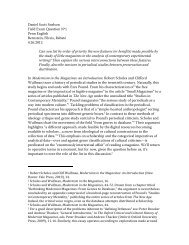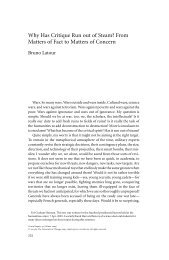The Exploit: A Theory of Networks - asounder
The Exploit: A Theory of Networks - asounder
The Exploit: A Theory of Networks - asounder
Create successful ePaper yourself
Turn your PDF publications into a flip-book with our unique Google optimized e-Paper software.
172 Notes<br />
these motor organs and to report, to ‘feed back,’ to the central control system<br />
as an artificial kinesthetic sense, we are already in a position to construct arti -<br />
ficial machines <strong>of</strong> almost any degree <strong>of</strong> elaborateness <strong>of</strong> performance.” Wiener,<br />
Cybernetics, 27.<br />
25. As Wiener elaborates, “Just as the amount <strong>of</strong> information in a system is<br />
a measure <strong>of</strong> its degree <strong>of</strong> organization, so the entropy <strong>of</strong> a system is a measure<br />
<strong>of</strong> its degree <strong>of</strong> disorganization; and the one is simply the negative <strong>of</strong> the<br />
other.” Wiener, Cybernetics, 11.<br />
26. Shannon and Weaver, A Mathematical <strong>The</strong>ory <strong>of</strong> Communication, 8.<br />
27. Von Bertalanffy, General Systems <strong>The</strong>ory, 121.<br />
28. Gilbert Simondon, “<strong>The</strong> Genesis <strong>of</strong> the Individual,” in Zone 6: Incorporations<br />
(New York: Zone, 1992), 300. In contrast to either atomist (constructionist)<br />
or hylomorphic (matter into form) theories <strong>of</strong> individuation,<br />
Simondon’s use <strong>of</strong> the term “individuation” begins and ends with the process<br />
<strong>of</strong> individuation, not its apparent start or end point. Simondon suggests that<br />
our electrical technologies <strong>of</strong> transduction provide a technical means by<br />
which material - energetic forms are regulated—individuation is therefore a<br />
“transduction.”<br />
29. Gilles Deleuze and Félix Guattari, A Thousand Plateaus (Minneapolis:<br />
University <strong>of</strong> Minnesota Press, 1987), 6.<br />
30. Gilles Deleuze, Difference and Repetition, trans. Paul Patton (New<br />
York: Columbia University Press, 1995), 182.<br />
31. Henri Bergson, <strong>The</strong> Creative Mind (New York: Citadel Press, 1997),<br />
147. Another way <strong>of</strong> stating this is to suggest that networks have no nodes.<br />
Brian Massumi corroborates this when he states that “in motion, a body is in<br />
an immediate, unfolding relation to its own nonpresent potential to vary....<br />
A thing is when it isn’t doing.” Brian Massumi, Parables for the Virtual<br />
(Durham: Duke University Press, 2002), 4, 6.<br />
32. John Arquilla and David Ronfeldt, “<strong>The</strong> Advent <strong>of</strong> Netwar,” in <strong>Networks</strong><br />
and Netwars, 5.<br />
33. Emmanuel Levinas, “Ethics as First Philosophy,” in <strong>The</strong> Levinas<br />
Reader, ed. Séan Hand (New York: Routledge, 1989), 82– 83.<br />
34. Ibid., 83.<br />
35. John Arquilla and David Ronfeldt, Swarming and the Future <strong>of</strong><br />
Conflict (Santa Monica: Rand, 2000), 8.<br />
36. Eric Bonabeau and Guy Théraulaz, “Swarm Smarts,” Scientific American,<br />
March 2000, 72– 79.<br />
37. Ibid., 21.<br />
38. Deleuze and Guattari, A Thousand Plateaus, 170.<br />
39. Ibid.<br />
40. Foucault <strong>of</strong>fers a distinction between the two types <strong>of</strong> power near<br />
the end <strong>of</strong> the first volume <strong>of</strong> <strong>The</strong> History <strong>of</strong> Sexuality, as well as in a 1976<br />
lecture at the Collège de France: “Unlike discipline, which is addressed to









